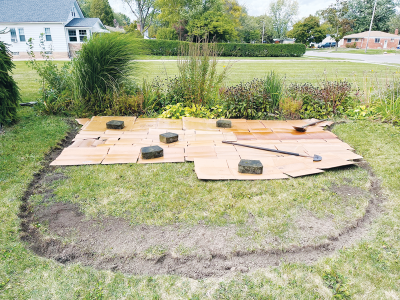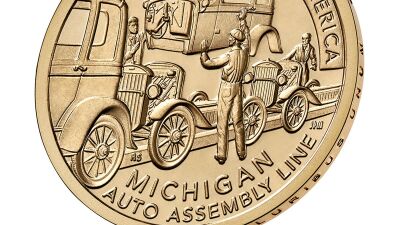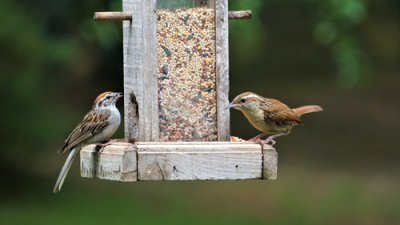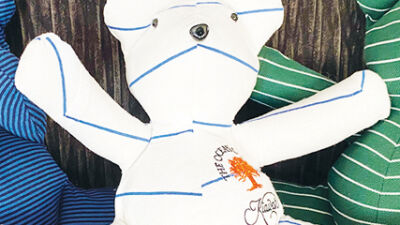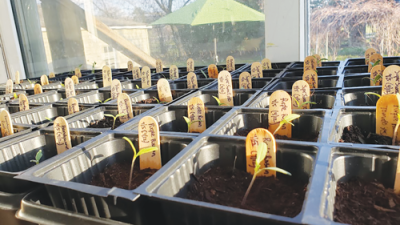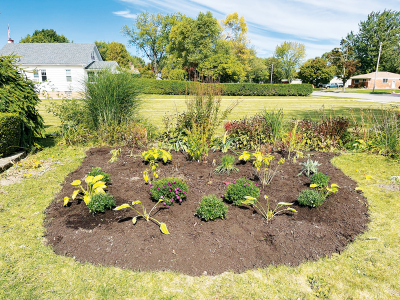
In the finished garden, soil covers the cardboard garden bed weed barrier.
Photo provided by Kristen Doetzkies
METRO DETROIT — Did you just move and have an excessive number of cardboard boxes around?
Rather than putting the boxes in the recycling bin, you can put them to good use in your own backyard. If you’re a gardener, many common household recyclable items have uses. From pie pans to cardboard boxes, repurposing these items can save you a trip to the store and help you recycle in a more direct way.
Cardboard can be an easy way to create a weed barrier that allows moisture to get in. To do this, flatten the boxes in the area you want to make a garden bed. Put water on the cardboard and put topsoil over it. Once this is set, start planting.
“Cardboard suppresses weeds by blocking sunlight and helps retain moisture in the soil, reducing the need for frequent watering,” Brian McDaid, of Eagle Dumpster Rental, said in a press release. “It breaks down naturally over time, enriching the soil with organic matter and improving its structure. This method also recycles cardboard that might otherwise end up in a landfill.”
Newspapers can serve a similar purpose. If you’re reading a paper copy of this story, we recommend you finish before you try out this method. Much like cardboard, newspaper can be used as a biodegradable weed barrier. Make sure the newspaper isn’t glossy and is free of any heavy inks. For instance, this paper would be just fine to use. You’ll need five layers to make this work, according to McDaid. Then lightly dampen the layers and add a covering of topsoil.
Caitlin Splawski, Michigan State University Extension consumer horticulture educator, cautioned those using newspaper and cardboard. For cardboard in particular, she said not to use pieces with a glossy finish and to remove all tape. She said opinions are split about using the materials, since it can cause a spike of carbon in the soil that may need to be balanced by adding nitrogen. Though, she said this lacks definitive research.
“It can affect gas exchange and water percolation into the soil in the short term,” Splawski said. “In the medium term, it can add a lot of carbon to the soil. If you don’t have the proper nutrition with fertilizer added in, that can cause some nutrient imbalances if that’s not addressed.”
She advised using more organic material like pine needles, straw and composted wood chips for a flower bed barrier.
Gardener Kelly Colegio, a former Warren City Council member who helped form the city’s community garden, said there are many items you can use to improve your garden.
“Anything you can imagine,” Colegio said.
In the kitchen, she said, old pie pans can be tied to rattle when a critter tries to find a snack from the garden. Pots can be used as a bird bath. Old teacups can be used as bird feeders. Jars can be repurposed for seeds. Old bread ties can be used in place of zip ties. Old plastic tubs can help as a container for picking berries.
Splawski said plastic containers can be used for many purposes but said sanitizing them with dish soap and water before use is important. Reusing potting containers may need more care. Plant diseases and pests can sometimes survive a normal wash, so using a bleach solution may be required. According to an Iowa State University article that Splawski provided, soak the container in a solution made up of one part bleach and nine parts water for 10 minutes and rinse. Be careful to protect your skin and clothes from the solution.
Colegio said she picked up many of these DIY methods from her mother, who passed away in 2019.
“I learned that you don’t have to buy a lot if you can just figure out how to repurpose what you have,” Colegio said.
She traced her mother’s thrifty outlook to her grandmother, who did these things out of necessity during the Great Depression. Some of these methods, like canning, could be utilized now to reduce waste, according to Colegio.
“Their mindset was different,” she said. “Perhaps not because they were looking to go green; they did it out of necessity. If we could go back and look at some of their practices of self-sustainability, a lot of them were green.”
Colegio said old nylons or old strips of shirts can be used to prop up plants. Old clothes can be put to use on a homemade scarecrow.
Even larger items like an old sink or a washtub can be used as a planter. Colegio uses an old mailbox as storage for gardening tools.
Splawski said old plastic milk containers can be used for winter sowing. She said some plants have a dormancy mechanism. By starting the seeds outside in a jug, it can make the seeds go through their natural cycle and promote growth.
“A lot of folks swear by it as the way to get — especially native plant — seeds started,” Splawski said.
“If you look at something, and you really look at it for a while, you can find a use for it out in the garden,” Colegio said.
McDaid echoes this idea in the release.
“A home garden is all about sustainability and independence,” McDaid said. “By being sustainable in how you start and maintain your garden by using things that would otherwise be trash, you’ll have a better gardening experience. One that is cheaper, requires less trips to the store, and is genuinely healthy for your plants.”
Composting can also be a good way to recycle, but that could be an article all its own. Splawski recommends that those interested in composting visit canr.msu.edu/resources/composting_a_smart_gardening_practice_to_recycle_garden_and_yard_waste.
 Publication select ▼
Publication select ▼